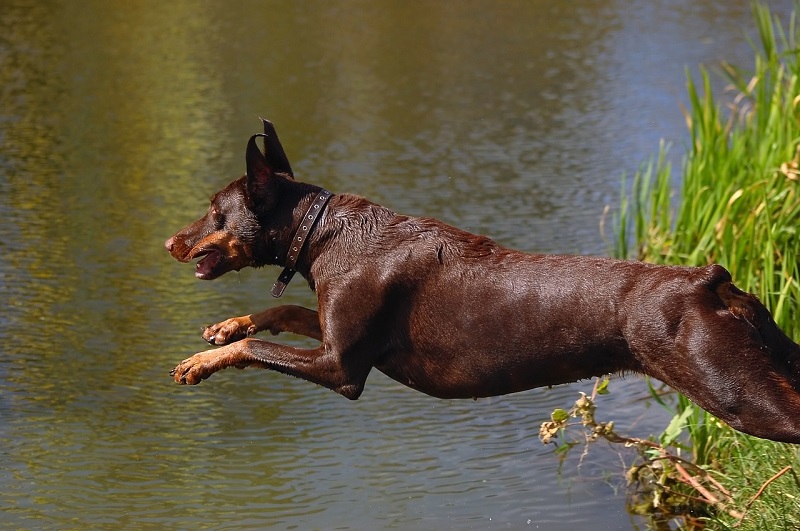A diagnosis of arthritis for your dog may come as a shock, but it doesn’t have to impact their quality of life. The degenerative bone and joint condition is actually quite common in canines, and although it can seem to restrict your dog from activities they formerly loved, small lifestyle adjustments can help them stay active safely and comfortably.
So, if you’re wondering how to help a dog with arthritis, this guide contains everything you need to know about your dog’s arthritis diagnosis, as well as a list of the best exercises for dogs with arthritis so that you can ensure you’re keeping your pup active while preventing pain.
What is Arthritis?
Arthritis, or osteoarthritis, is a condition that affects both humans and dogs. However, it’s extremely common in dogs,1 affecting at least 1 in 3.2 A degenerative condition, primary arthritis means a loss of joint cartilage, which leads to joint pain and other changes in the bones as a dog ages. These changes, in turn, cause inflammation and make it difficult to use the affected limb normally.
Although there is no cure for osteoarthritis, its progression can be slowed and the associated pain managed.
Secondary arthritis is even more common in dogs.3 Unlike the aforementioned primary arthritis, secondary canine arthritis occurs when abnormal pressure is placed on a joint or its cartilage (i.e. as a result of an injury rather than the expected degeneration from aging). This causes pain and inflammation, eventually leading to dog arthritis.
What Does Arthritis Look Like in Dogs?
One of the first signs a dog is in pain and has arthritis is a decrease in physical activity. Most dogs love to exercise—you might have noticed a Pavlovian response to the word “walk.” This is why a lack of desire to run around (or a new lameness to your dog’s gait) is a bad sign.
Obesity is also a major risk factor for dogs developing arthritis, as excess weight can place a strain on the joints. If your pup has recently gained weight, you might notice a slowness or a lack of interest in play that could be the result of pain from arthritis.
Importantly, since arthritis happens naturally as many dogs age, weight management is one of the only ways to prevent it.
Aside from a general slowness and decrease in physical activity, signs and symptoms of arthritis in dogs can include4:
- Limping
- Stiffness
- Groaning
- Using caution when getting up or lying down
- Fatigue
- Irritability
- Chewing or licking at areas that may be painful, not letting you touch them
If you regularly notice these symptoms in your pet, it’s best to make a vet appointment. A physical exam (and possibly an X-ray) will determine for sure whether canine arthritis is the cause of the pain.

Causes of Arthritis in Dogs
As mentioned above, the most common causes of arthritis in dogs are aging and obesity. However, certain other factors may cause arthritis at any point in a dog’s life. These include:
- An injury, such as a broken bone or ligament damage (even far in the past), or an infection (for secondary arthritis)
- Hip dysplasia or elbow dysplasia, conditions caused by genetics (and therefore most common in Labradors and German Shepherds)
- Genetics in general—certain breeds (like Labradors and German Shepherds, as well as Dachshunds, St. Bernards, Rottweilers, and more) are predisposed to dog arthritis
- Abnormalities in joints (could be a result of too much or too little exercise during puppyhood)
- Complications from orthopedic surgery
- Poor eating habits
While many of these factors are not preventable, there are still steps you can take to decrease your dog’s chances of developing arthritis symptoms (or at least ease the symptoms).
Be sure to develop an appropriate diet and exercise regimen per your vet’s recommendations (including joint supplement as needed), and follow your vet’s instructions closely when helping your pet heal from an injury or infection.
Meeting Dogs’ Exercise Needs
Helping your pet meet their exercise needs is one of your most crucial responsibilities as an owner. After all, much of the time you spend with your dog is likely on walks or during play sessions.
However, striking a balance can be tricky, as over-exercise can strain the joints and exercise needs vary based on age, size, and breed. When in doubt, it’s always best to consult your vet.
In general, puppies have more energy—they “get the zoomies”—and therefore require more exercise in shorter bursts throughout the day.5 Meanwhile, a senior dog has a lot less energy and may be reluctant to move at the speed they used to. However, it’s still essential for them to get in a gentle daily workout.
Most dogs need anywhere from 30 minutes to two hours of exercise per day,6 which can be divided into multiple walks or play sessions as needed.
But there’s no need to feel restricted to walks and fetch—there are a number of ways to ensure your pup gets exercise, including:
- Running
- Cycling alongside your dog
- Swimming
- Agility training or other dog sports
- Puzzle games/puzzle feeders
- Scent training
- Hiking
- Yoga (at a local dog yoga class or at home/with an online video)
Put simply, there are endless ways to keep your pup moving, regardless of energy levels. Just getting their heart rate up at least once a day will decrease their risk of various health complications.

Best Exercises for Dogs with Arthritis
Ensuring your pup stays active while battling dog arthritis symptoms can be a challenge, especially when they’re reluctant to get moving. Luckily, there are certain exercises and modifications you can use to help your pet stay on track while reducing pain.
In general, an exercise regimen for a pup fighting arthritis should be regular, low-impact, and controlled.
Interestingly, studies have shown that dogs with arthritis who exercise for over an hour a day have lower levels of lameness (muscle atrophy) than dogs with arthritis who exercise for 20 minutes or less.7
So, while you shouldn’t push your dog to do high-impact exercise that’s become painful, getting a solid amount of low-impact exercise daily will be beneficial in the long run. The good news? There are a variety of ways to decrease impact when it comes to the activities your pup already loves. Let’s explore more below.
Reduce Mass to Reduce Impact
One way to make exercises for dogs with arthritis low-impact is by reducing your dog’s mass, and therefore, the amount of weight placed on the joints. The only way to do this (without waiting for your dog to lose weight) is with water exercise.
Swimming is an ideal low-impact exercise option for arthritic dogs, as are underwater treadmills. If you don’t want to invest in your own underwater treadmill, see if you can access one at your vet’s office or a pet physical therapy practice.
Reduce Force to Reduce Impact
Another way to reduce the impact of exercise is by reducing force—in other words, decreasing acceleration in order to reduce how quickly force is applied to a joint.
This can be done by discouraging running or jumping in daily play (particularly jumping down, such as down a flight of stairs).
Add Control to Reduce Impact
Controlled exercises, like walking your dog slowly on a leash rather than allowing them to run freely at the dog park, are generally more low-impact. You can also facilitate controlled exercise by adding an obstacle to your dog’s daily outdoor time, such as an agility course, a pool, or tall grass.8
However, keep in mind that your dog has social needs as well, and the dog park might be the highlight of his day. In cases like this when you want to let your dog play or chase a ball freely, make sure to incorporate a “warm-up” walk in order to mitigate any joint impact.9 Taking the time to walk to the dog park rather than driving, or timing your fetch sessions after your daily walks, can make a significant difference in your pup’s long-term comfort.
Try Physical Therapy
Finally, you always have the option to find a certified small animal physical rehabilitation practitioner in your area. They can incorporate therapeutic exercise into your pet’s routine to help reduce pain during everyday activities.
Rehabilitation might look like light stretching, range of motion exercises, controlled walking, swimming, or walking on an underwater treadmill. Your pet will also be regularly assessed so that you can track their progress.
Working with a professional might also help you feel more comfortable if you’re not sure of your pet’s new ability level, and charting improvements over time can put your mind at ease.
Promote Better Bone and Joint Health Naturally with Vetericyn
Whether your pet just received an arthritis diagnosis or you’re simply hoping to keep them feeling young and sprightly for years to come, you can give their health and well-being a boost with Vetericyn’s ALL-IN dog supplement.
It’s packed with joint-healthy ingredients like collagen, calcium, and vitamin D3, and is also designed to support healthy muscles, a balanced mood, and even a shiny coat.
ALL-IN’s one-of-a-kind absorption technology is all-natural, and it’s available in puppy, adult, and senior formulas to support your pup’s age-specific needs.
If you’re looking to provide your best friend with holistic wellness support, our ALL-IN multifunctional supplement has you covered. Just stock up in our online store and give it to your pet like a daily vitamin.
 Reviewed by C. Scott Van Winkle
Reviewed by C. Scott Van Winkle
Scott has been with Innovacyn for the past 11 years and has been working within the Burlingame portfolio of companies for the past 23 years. Scott brings a diverse background to Innovacyn. With an upbringing as the 5th generation on his families cattle ranch, Scott has a passion for animal health and the continuous improvement surrounding agricultural practices. Scott earned marketing and business management degrees from the University of Idaho and holds an Executive MBA from Pepperdine University.
Sources:
- Cornell College of Veterinary Medicine. Osteoarthritis. https://www.vet.cornell.edu/departments/riney-canine-health-center/canine-health-information/osteoarthritis
- CARE (Canine Arthritis Resources and Education). The Truth About Canine Arthritis. https://caninearthritis.org/
- Texas A&M University, Veterinary Medicine & Biomedical Studies. Arthritis in Dogs. https://vetmed.tamu.edu/news/pet-talk/arthritis-in-dogs/
- Blue Cross UK. Arthritis in Dogs. https://www.bluecross.org.uk/advice/dog/health-and-injuries/arthritis-in-dogs
- American Kennel Club. How Much Exercise Does a Dog Need Every Day? https://www.akc.org/expert-advice/health/how-much-exercise-does-dog-need/
- PetMD. Exercising with Your Dog 101. https://www.petmd.com/dog/wellness/evr_dg_exercising_with_your_dog101
- CARE (Canine Arthritis Resources and Education). Activity Modifications for Dogs with Arthritis. https://caninearthritis.org/article/activity-modifications/
- Colorado State University, James L. Voss Veterinary Teaching Hospital. Arthritis Management and Prevention. https://vetmedbiosci.colostate.edu/vth/services/orthopedic-medicine/arthritis-management-and-prevention/